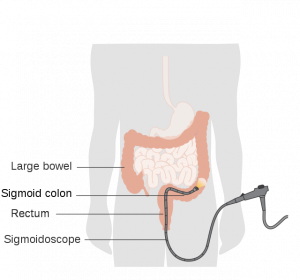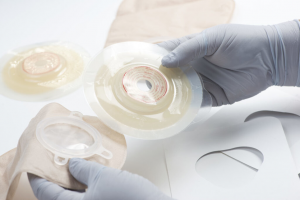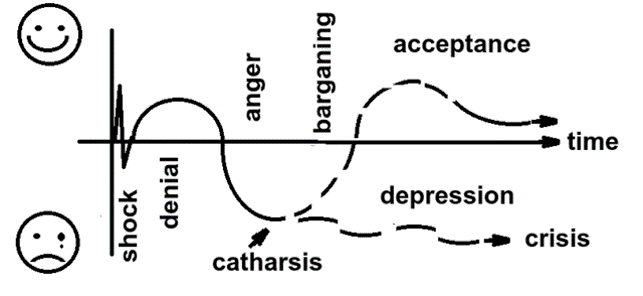Hugh’s Health: Colon Cancer
Stages of Colon Cancer
Stage 0 (Carcinoma in Situ)
- Abnormal cells found in the mucosa of the colon wall.
- These cells may become cancer and spread into nearby normal tissue.
Stage I Colon Cancer
- Cancer has formed in the mucosa of the colon wall.
- Has spread to the submucosa or to the muscle layer of the colon wall.
Stage II Colon Cancer
Is divided into stages IIA, IIB, and IIC:
Stage IIA
- Cancer has spread through the muscle layer of the colon to the serosa of the colon wall.
Stage IIB
- Cancer has spread through the serosa of the colon wall to the tissue that lines the organs in the abdomen.
Stage IIC
- Cancer has spread through the serosa of the colon wall to nearby organs
Stage III Colon Cancer
Is divided into stages IIIA, IIIB, and IIIC:
Stage IIIA
- Spread through the mucosa to the submucosa or the muscle layer and spread into 1 to 3 nearby lymph nodes or cancer cells have formed in tissue near the lymph nodes.
- Or through the mucosa to the submucosa and spread to 4 to 6 nearby lymph nodes.
Stage IIIB
- Spread through the muscle layer to the serosa or has spread through the serosa to the tissue that lines the organs in the abdomen.
- Spread to 1 to 3 nearby lymph nodes or cancer cells have formed in tissue near the lymph nodes.
- Spread to the muscle layer or to the serosa and to 4 to 6 nearby lymph nodes.
- Through the mucosa to the submucosa or to the muscle layer and spread to 7 or more nearby lymph nodes.
Stage IIIC
- Spread through the serosa to the tissue that lines the abdominal organs and spread to 4 to 6 nearby lymph nodes.
- Through the muscle layer to the serosa or spread through the serosa to the tissue that lines the abdominal organs and spread to 7 or more nearby lymph nodes.
- Spread through the serosa to nearby organs and spread to 1 or more nearby lymph nodes or cancer cells have formed in tissue near the lymph nodes.
Stage IV colon cancer
Is divided into stages IVA, IVB, and IVC:
Stage IVA
- Spread to one area or organ that is not near the colon or a distant lymph node.
Stage IVB
- Spread to more than one area or organ that is not near the colon or a distant lymph node.
Stage IVC
- Spread to the tissue that lines the wall of the abdomen and may have spread to other areas or organs.
Risk Factors for Colorectal Cancer
- Family history of colon or rectal cancer in a first-degree relative
- A personal history of cancer of the colon, rectum, or ovary
- Personal history of high-risk adenomas (colorectal polyps that are 1 cm or larger, or have abnormal cells)
- Inherited changes in certain genes that increase the risk (familial adenomatous polyposis or Lynch syndrome)
- Personal history of chronic ulcerative colitis or Crohn disease for 8 or more years
- 3 or more alcoholic drinks per day
- Smoking cigarettes
- Being black
- Being obese
- Older age
Symptoms
- Change in bowel habits
- Blood (either bright red or very dark) in the stool
- Diarrhea, constipation, or feeling that the bowel does not empty
- Stools that are narrower than usual
- Frequent gas pains, bloating, fullness, or cramps
- Weight loss for no known reason
- Feeling very tired
- Vomiting
Diagnostic Tests
- Physical exam and health history
- Digital rectal exam
- Fecal occult blood test (FOBT)
-
- Guaiac FOBT
- Immunochemical FOBT
- Barium enema
- Sigmoidoscopy
Surgical Treatment
- Resection of the colon with colostomy
- Unable to sew the 2 ends of the colon together
- A stoma (an opening) is made outside the body
- Waste passes through this opening a bag is placed around the stoma to collect the waste
- It can be reversed
Life Post-Colostomy
- Monitor your medications. Some meds can cause constipation or diarrhea.
- Eat a well-balanced diet. Avoid foods that cause a lot of gas.
- Live your life.
Concerns:
- Body image/self-esteem
- Relationships
- Self-care
Phases of Psychological Adaptation
Almost every patient goes through 4 phases of recovery following an accident or illness that results in loss of function of an important part of the body.
The patient and family go through these phases, varying only in the time required for each phase.
Some people may skip certain phases entirely and some may move up and down at different times.
- Shock or panic: tearful, anxious and forgetful.
- Defense/retreat/denial: denies or minimizes the significance of the event, defends themselves against the implications of the event.
- Acknowledgement: begins to face the reality of the situation. Gives up the old life, and may enter a period of depression, of apathy, of agitation, of bitterness, and of high anxiety.
- Adaptation/resolution: acute grief begins to subside. Coping in a constructive manner and begins to establish new structures. Develops a new sense of worth.






